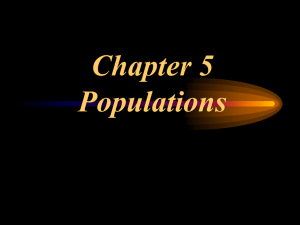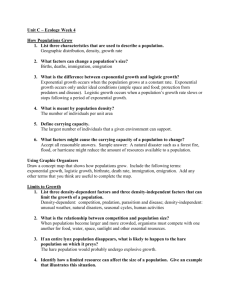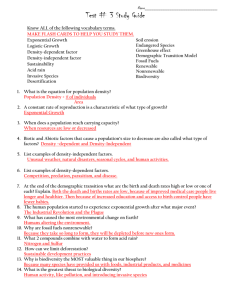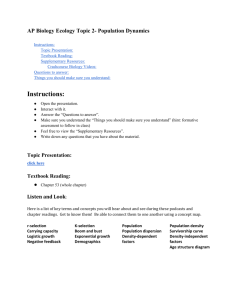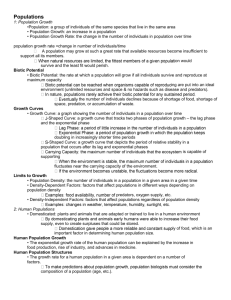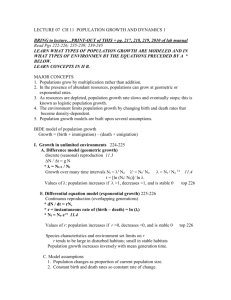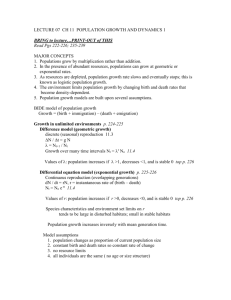Worksheet 29 Key - Iowa State University
advertisement
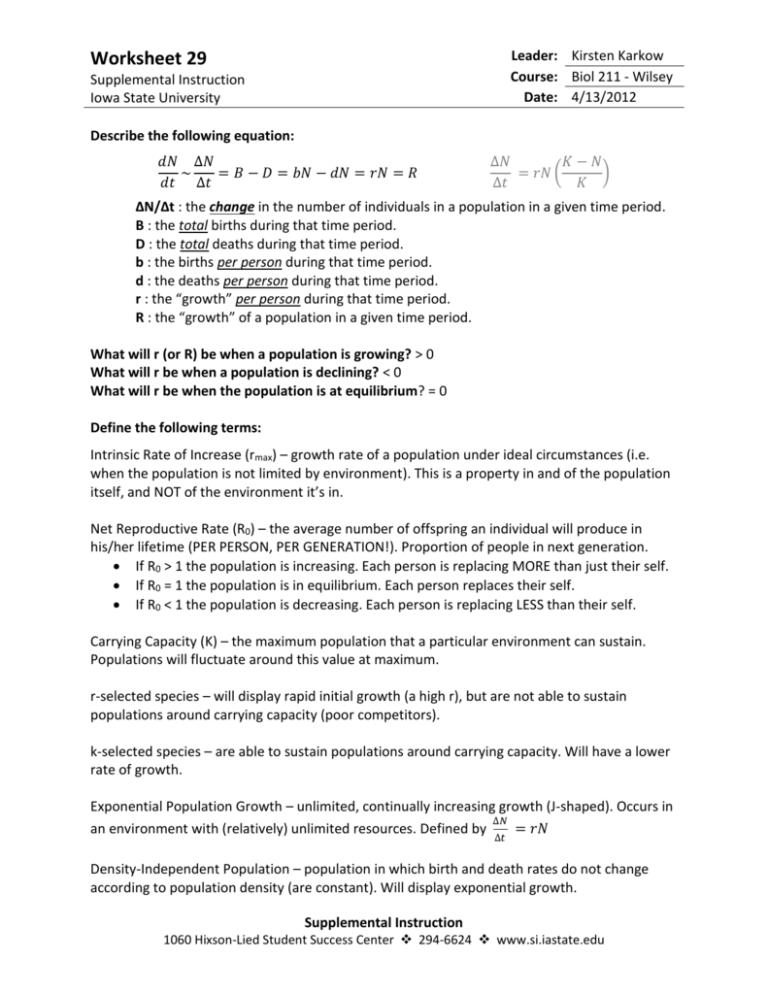
Leader: Kirsten Karkow Course: Biol 211 - Wilsey Date: 4/13/2012 Worksheet 29 Supplemental Instruction Iowa State University Describe the following equation: 𝑑𝑁 ∆𝑁 ~ = 𝐵 − 𝐷 = 𝑏𝑁 − 𝑑𝑁 = 𝑟𝑁 = 𝑅 𝑑𝑡 ∆𝑡 ∆𝑁 𝐾−𝑁 = 𝑟𝑁 ( ) ∆𝑡 𝐾 ΔN/Δt : the change in the number of individuals in a population in a given time period. B : the total births during that time period. D : the total deaths during that time period. b : the births per person during that time period. d : the deaths per person during that time period. r : the “growth” per person during that time period. R : the “growth” of a population in a given time period. What will r (or R) be when a population is growing? > 0 What will r be when a population is declining? < 0 What will r be when the population is at equilibrium? = 0 Define the following terms: Intrinsic Rate of Increase (rmax) – growth rate of a population under ideal circumstances (i.e. when the population is not limited by environment). This is a property in and of the population itself, and NOT of the environment it’s in. Net Reproductive Rate (R0) – the average number of offspring an individual will produce in his/her lifetime (PER PERSON, PER GENERATION!). Proportion of people in next generation. If R0 > 1 the population is increasing. Each person is replacing MORE than just their self. If R0 = 1 the population is in equilibrium. Each person replaces their self. If R0 < 1 the population is decreasing. Each person is replacing LESS than their self. Carrying Capacity (K) – the maximum population that a particular environment can sustain. Populations will fluctuate around this value at maximum. r-selected species – will display rapid initial growth (a high r), but are not able to sustain populations around carrying capacity (poor competitors). k-selected species – are able to sustain populations around carrying capacity. Will have a lower rate of growth. Exponential Population Growth – unlimited, continually increasing growth (J-shaped). Occurs in ∆𝑁 an environment with (relatively) unlimited resources. Defined by ∆𝑡 = 𝑟𝑁 Density-Independent Population – population in which birth and death rates do not change according to population density (are constant). Will display exponential growth. Supplemental Instruction 1060 Hixson-Lied Student Success Center 294-6624 www.si.iastate.edu Logistic Population Growth – growth that will level off as N approaches K (S-shaped). Occurs when there is some form of environmental resistance. Defined by ∆𝑁 ∆𝑡 𝐾−𝑁 = 𝑟𝑁 ( 𝐾 ) Density-Dependent Population – population in which birth rates will fall or death rates will rise with higher population density. Will display logistic population growth (exponential at first). Under what conditions is exponential growth more likely to occur? Scenarios in which the population size is very small relative to K. Organisms are introduced to a new (previously unoccupied) environment. Rebounding from some catastrophe. What prevents exponential population growth from continuing indefinitely? (Notice that these are factors that only affect density-DEPENDENT populations.) Depletion of resources (food, shelter, etc.) Build-up of wastes Increased incidence of disease Increased predation Poor competition (r-selected) leading to population crashes List some things that will affect the population size of density-INDEPENDENT populations: Natural disasters: floods, earthquakes, volcano eruptions, etc. A few notes on humans: Humans have not reached K. We are still technically in the “exponential” phase. Eventually we may run into problems with limited space, water, wastes, etc. Unlike other organisms, humans can decide whether K will be reached – we can make social changes to limit our growth (think China) and invent solutions to increasing K. Practice population ecology (math) questions. 1. You are trying to estimate the population size of a herd of zebras. You tag 100 zebras, then let them go. After some time, you recollect 200 zebras and find that 25 of them have tags. What is the population size of the herd? = (100 * 200)/25 = 800 2. In a population of 1000 people, there are 150 births and 200 deaths per year. Find the following: The population GROWTH during that year: -50 people The population size after one year: 950 The per capita growth rate: -.05 3. In a certain year, the birth rate is .2 per capita while the death rate is .1 per capita. The population is composed of one million people. Find the following: The growth rate per capita: .1 The total growth in one year: 100,000 The population size after one year: 1,100,000 4. A population of 100 platypuses has a constant net reproductive rate equal to 1.5. Find the following: The population size after one generation: 150 The population size after two generations: 225 (100 * 1.5 + 150 * 1.5) 5. For question #3, calculate ΔN/Δt assuming each of the following carrying-capacities: K = 100 million: ΔN/Δt = 99,000 K = 2 million: ΔN/Δt = 50,000 K = 1.1 million: ΔN/Δt = 9091
